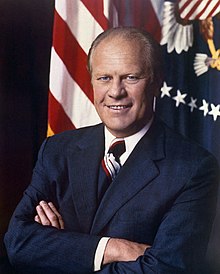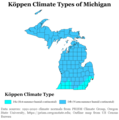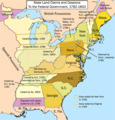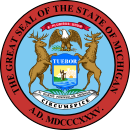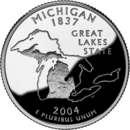Portal:Michigan
The Michigan Portal  Michigan (/ˈmɪʃɪɡən/ MISH-ig-ən) is a state in the Great Lakes region of the Upper Midwest region of the United States. It borders Wisconsin to the northwest in the Upper Peninsula, and Indiana and Ohio to the south in the Lower Peninsula; it is also connected by Lakes Superior, Michigan, Huron, and Erie to Minnesota and Illinois, and the Canadian province of Ontario. With a population of nearly 10.12 million and an area of 96,716 sq mi (250,490 km2), Michigan is the 10th-largest state by population, the 11th-largest by area, and the largest by area east of the Mississippi River. Its capital is Lansing, and its largest city is Detroit. Metro Detroit is among the nation's most populous and largest metropolitan economies. The name derives from a gallicized variant of the original Ojibwe word ᒥᓯᑲᒥ (mishigami), meaning "large water" or "large lake". Michigan consists of two peninsulas. The Lower Peninsula resembles the shape of a mitten, and comprises a majority of the state's land area. The Upper Peninsula (often called "the U.P.") is separated from the Lower Peninsula by the Straits of Mackinac, a five-mile (8 km) channel that joins Lake Huron to Lake Michigan. The Mackinac Bridge connects the peninsulas. Michigan has the longest freshwater coastline of any political subdivision in the United States, being bordered by four of the five Great Lakes and Lake St. Clair. It also has 64,980 inland lakes and ponds. Michigan has the second-most water area of any state, behind only Alaska. The area was first occupied by a succession of Native American tribes over thousands of years. In the 17th century, French explorers claimed it as part of the New France colony, when it was largely inhabited by Indigenous peoples. French and Canadian traders and settlers, Métis, and others migrated to the area, settling largely along the waterways. After France's defeat in the French and Indian War in 1762, the region came under British rule. Britain ceded the territory to the newly independent United States after its defeat in the American Revolutionary War. The area was part of the larger Northwest Territory until 1800, when western Michigan became part of the Indiana Territory. Michigan Territory was formed in 1805, but some of the northern border with Canada was not agreed upon until after the War of 1812. Michigan was admitted into the Union in 1837 as the 26th state, a free one. It soon became an important center of industry and trade in the Great Lakes region, attracting immigrants in the late 19th and early 20th centuries from many European countries. Immigrants from Finland, Macedonia, and the Netherlands were especially numerous. Migration from Appalachia and of Black Southerners as part of the Great Migration increased in the 1930s, with many settling in Metro Detroit. Although Michigan has developed a diverse economy, in the early 20th century it became widely known as the center of the U.S. automotive industry, which developed as a major national economic force. It is home to the country's three major automobile companies (whose headquarters are all in Metro Detroit). Once exploited for logging and mining, today the sparsely populated Upper Peninsula is important for tourism because of its abundance of natural resources. The Lower Peninsula is a center of manufacturing, forestry, agriculture, services, and high-tech industry. (Full article...) Entries here consist of Good and Featured articles, which meet a core set of high editorial standards.
The White Stripes were an American rock duo formed in Detroit, Michigan, in 1997. The group consisted of Jack White (guitar, keyboards, piano, and vocals) and Meg White (drums, percussion, and vocals). They were a leading group of the 2000s indie rock and garage rock revival. Beginning in the late 1990s, the White Stripes sought success within the Detroit music scene, releasing six singles and two studio albums, their self-titled debut album (1999) and De Stijl (2000). They rose to prominence with their critically acclaimed albums White Blood Cells (2001) and Elephant (2003), which propelled them to the forefront of the garage rock revival scene. The single "Seven Nation Army", which used a guitar and an octave pedal to create the opening riff, became one of their most recognizable songs. The band released two more albums, Get Behind Me Satan (2005) and Icky Thump (2007), and the documentary Under Great White Northern Lights (2009), before dissolving in 2011 after a lengthy hiatus from performing and recording. (Full article...)Selected picture - U.S. Highway 127 (US 127) runs for 214.12 miles (344.59 km) in the U.S. state of Michigan. The highway enters Michigan from Ohio south of Hudson and ends at a partial interchange with I-75 south of Grayling. Prior to 2002, US 127 ended at I-69 north of East Lansing, a total of approximately 83 miles (134 km). Did you know -
Related portalsSelected article - Pictured Rocks National Lakeshore is a U.S. National Lakeshore in the Upper Peninsula of Michigan, United States. It extends for 42 mi (68 km) along the shore of Lake Superior and covers 73,236 acres (114 sq mi; 296 km2). The park has extensive views of the hilly shoreline between Munising and Grand Marais in Alger County, with picturesque rock formations, waterfalls, and sand dunes. Pictured Rocks derives its name from the 13 miles (24 km) of colorful sandstone cliffs northeast of Munising. The cliffs reach up to 200 feet (60 m) above lake level. They have been naturally sculptured into a variety of shallow caves, arches, and formations resembling castle turrets and human profiles. Near Munising, visitors can also visit Grand Island, most of which are included in the separate Grand Island National Recreation Area. (Full article...)Selected biography -Gerald Rudolph Ford Jr. (/ˈdʒɛrəld/ JERR-əld; born Leslie Lynch King Jr.; July 14, 1913 – December 26, 2006) was an American politician who served as the 38th president of the United States from 1974 to 1977. He previously served as the leader of the Republican Party in the U.S. House of Representatives from 1965 to 1973, and as the 40th vice president under President Richard Nixon from 1973 to 1974. Ford succeeded to the presidency when Nixon resigned in 1974, but was defeated for election to a full term in 1976. Ford is the only person to serve as president without winning an election for president or vice president. Ford was born in Omaha, Nebraska and raised in Grand Rapids, Michigan. He attended the University of Michigan, where he played for the school's football team before eventually attending Yale Law School. Afterward, he served in the U.S. Naval Reserve from 1942 to 1946. Ford began his political career in 1949 as the U.S. representative from Michigan's 5th congressional district, serving in this capacity for nearly 25 years, the final nine of them as the House minority leader. In December 1973, two months after Spiro Agnew's resignation, Ford became the first person appointed to the vice presidency under the terms of the 25th Amendment. After the subsequent resignation of President Nixon in August 1974, Ford immediately assumed the presidency. (Full article...)General imagesThe following are images from various Michigan-related articles on Wikipedia.
TopicsCategoriesSymbols
Lists
Related pagesWikimediaThe following Wikimedia Foundation sister projects provide more on this subject:
Things you can doDiscover Wikipedia using portals | ||||||||||||||||||||||||||||||||||||


